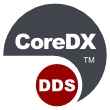CoreDX DDS on FPGAs
Field Programmable Gate Arrays are a fast, versatile, scalable, and inexpensive development platform. FPGAs often need to communicate and interoperate with GPPs, DSPs, and other FPGAs. Software must manage these highly interconnected communications and interoperability issues, while still delivering optimal performance and reliability. It’s not surprising that as more development occurs on FPGAs, developers want the functionality and convenience of a middleware like DDS.
CoreDX DDS Helps FPGA Developers: The standardized API of CoreDX DDS supports portability across all platforms, including FPGAs. This level of portability is critical to reducing the cost of development, testing and maintenance. Deploying the same code baseline across multiple hardware and Operating System environments helps to quickly multiply your project resources. The testing and lifecycle maintenance effort is in direct proportion to the size of the project source code -- a smaller baseline means reduced costs. Further, code portability simplifies the development process. Developers can perform preliminary testing on a more standard processor platform (Intel, MIPS, PowerPC, ARM, etc); and then migrate to the FPGA platform with a simple re-compile.
CoreDX DDS Helps Embedded Developers: CoreDX DDS provides many features difficult to implement by hand, and not found in other IPC libraries. CoreDX DDS requires minimal operating system services, offering high performance and scalability with a low line of code count and small footprint. With options like data filtering and storage, data presentation, and event notification, CoreDX DDS allows programmers to focus on their applications and the code they love to write, instead of communication details.
CoreDX DDS helps Software Architects: With CoreDX DDS, software systems can be extended and modified, even after deployment, with little or no change required to application software.
Program Managers like CoreDX DDS because it helps them mitigate their schedule and budget risk. CoreDX DDS is cost effective, reducing engineering and maintenance labor costs over the lifecycle of the project. CoreDX DDS allows existing technical resources to focus on meeting project requirements and milestones.
CoreDX DDS is an easy-to-use, cross-platform, cross-language Inter-Process Communication (IPC) library providing robust, flexible, and dynamic data communications. CoreDX DDS is the leading small-footprint DDS Middleware available, and supports the widest range of devices from FPGAs and DSPs to enterprise and high-availability servers.
Based on Open Standards for guaranteed interoperability and long term viability, CoreDX DDS is the preferred IPC for a wide variety of distributed software programs: from mobile games and consumer electronic devices to surgical equipment, health care applications, complex DoD systems and robots working in space.
CoreDX DDS Features: CoreDX DDS is essential for effective Open System architectures. CoreDX DDS is the only fully interoperable DDS implementation available for FPGAs such as those from Xilinx or Altera.
• Designed to be easily certifiable
• High Performance with a small footprint and easily scalable
• No Recursion
• Standards Compliant
• Minimal operating system services requirements
• CoreDX DDs brings the same standardized DDS API and interoperable wire protocol to FPGAs.
• CoreDX DDS can use wired/wireless/serial transport like Zigbee
CoreDX DDS Benefits:
• Enables easy integration and interoperability of FPGAs with DSPs wand GPPs, all in a single system
• Separates the application code from the communication transfer, so you don’t rewrite common protocols each time
• CoreDX DDs allows you to send data to FPGAs without being an expert
• Reduces costs
• Faster Time to Market
How CoreDX DDS and FPGA work:
CoreDX DDS can work with various Operating Systems (OS's), from full-featured OS's like Linux to highly embedded OS's like ThreadX or Micrium. All of these Operating Systems provide support for operation on an FPGA. In this case, the FPGA is programmed to behave like a Central Processing Unit (CPU), and the Operating System is hosted on top of this. For example, Xilinx provides the MicroBlaze soft-cpu logic for their FPGA's. CoreDX DDS can support Linux, ThreadX and Micrium RTOS on this CPU configuration. Altera offers the Nios II soft-cpu for their line of FPGA chips. Again, CoreDX DDS can support this CPU under a wide variety of OS's and RTOSs.

Ordering Information:
Contact your Twin Oaks Computing account manager or email contact@twinoakscomputing.com
About Twin Oaks Computing:
Twin Oaks Computing, Inc. is a company dedicated to developing and delivering quality software solutions. We build the software that collects, manages, and distributes information in a wide range of industries. Our software is in use around the world supporting critical missions.
Super-small and blazingly fast, our flagship product, CoreDX DDS is the leading Publish-Subscribe Data Distribution Service middleware available for small-footprint and embedded systems.
###
Twin Oaks, Twin Oaks Computing, CoreDX DDS are all registered trademarks or trademarks of Twin Oaks Computing, Inc. All other trademarks are property of their respective companies.







